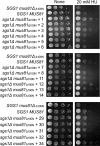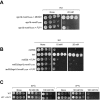The possible function of Flp1 in homologous recombination repair in Saccharomyces cerevisiae
- PMID: 31435519
- PMCID: PMC6698574
- DOI: 10.3934/genet.2018.2.161
The possible function of Flp1 in homologous recombination repair in Saccharomyces cerevisiae
Abstract
Saccharomyces cerevisiae Mus81 is a structure-selective endonuclease which constitutes an alternative pathway in parallel with the helicase-topoisomerase Sgs1-Top3-Rmi1 complex to resolve a number of DNA intermediates during DNA replication, repair, and homologous recombination. Previously, it was showed that the N-terminal region of Mus81 was required for its in vivo function in a redundant manner with Sgs1; mus81Δ120N mutant that lacks the first 120 amino acid residues at the N-terminus exhibited synthetic lethality in combination with the loss of SGS1. In this study, the physiologically important role of the N-terminal region of Mus81 in processing toxic intermediates was further investigated. We examined the cellular defect of sgs1Δmus81Δ100N cells and observed that although viable, the cells became very sensitive to DNA damaging agents. A single-copy suppressor screening to seek for a factor(s) that could rescue the drug sensitivity of sgs1Δmus81Δ100N cells was performed and revealed that Flp1, a site-specific recombinase 1 encoded on the 2-micron plasmid was a suppressor. Moreover, Flp1 overexpression could partially suppress the drug sensitivity of mus81Δ cells at 37 °C. Our findings suggest a possible function of Flp1 in coordination with Mus81 and Sgs1 to jointly resolve the branched-DNA structures generated in cells attempting to repair DNA damages.
Keywords: Flp1; Mus81; Sgs1; genetic screening; homologous recombination repair.
Conflict of interest statement
Conflict of interest: All authors declare no conflicts of interest in this paper.
Figures






Similar articles
-
A physiological significance of the functional interaction between Mus81 and Rad27 in homologous recombination repair.Nucleic Acids Res. 2015 Feb 18;43(3):1684-99. doi: 10.1093/nar/gkv025. Epub 2015 Jan 27. Nucleic Acids Res. 2015. PMID: 25628354 Free PMC article.
-
Yeast Rmi1/Nce4 controls genome stability as a subunit of the Sgs1-Top3 complex.Mol Cell Biol. 2005 Jun;25(11):4476-87. doi: 10.1128/MCB.25.11.4476-4487.2005. Mol Cell Biol. 2005. PMID: 15899853 Free PMC article.
-
Roles of SGS1, MUS81, and RAD51 in the repair of lagging-strand replication defects in Saccharomyces cerevisiae.Curr Genet. 2005 Oct;48(4):213-25. doi: 10.1007/s00294-005-0014-5. Epub 2005 Nov 4. Curr Genet. 2005. PMID: 16193328 Free PMC article.
-
Functional and physical interaction between Sgs1 and Top3 and Sgs1-independent function of Top3 in DNA recombination repair.Genes Genet Syst. 2002 Feb;77(1):11-21. doi: 10.1266/ggs.77.11. Genes Genet Syst. 2002. PMID: 12036100
-
[Functional analysis of yeast homologue gene associated with human DNA helicase causative syndromes].Kokuritsu Iyakuhin Shokuhin Eisei Kenkyusho Hokoku. 2002;(120):53-74. Kokuritsu Iyakuhin Shokuhin Eisei Kenkyusho Hokoku. 2002. PMID: 12638184 Review. Japanese.
References
-
- Nishino T, Komori K, Ishino Y, et al. X-ray and biochemical anatomy of an archaeal XPF/Rad1/Mus81 family nuclease: similarity between its endonuclease domain and restriction enzymes. Structure. 2003;11:445–457. - PubMed
LinkOut - more resources
Full Text Sources
Molecular Biology Databases

